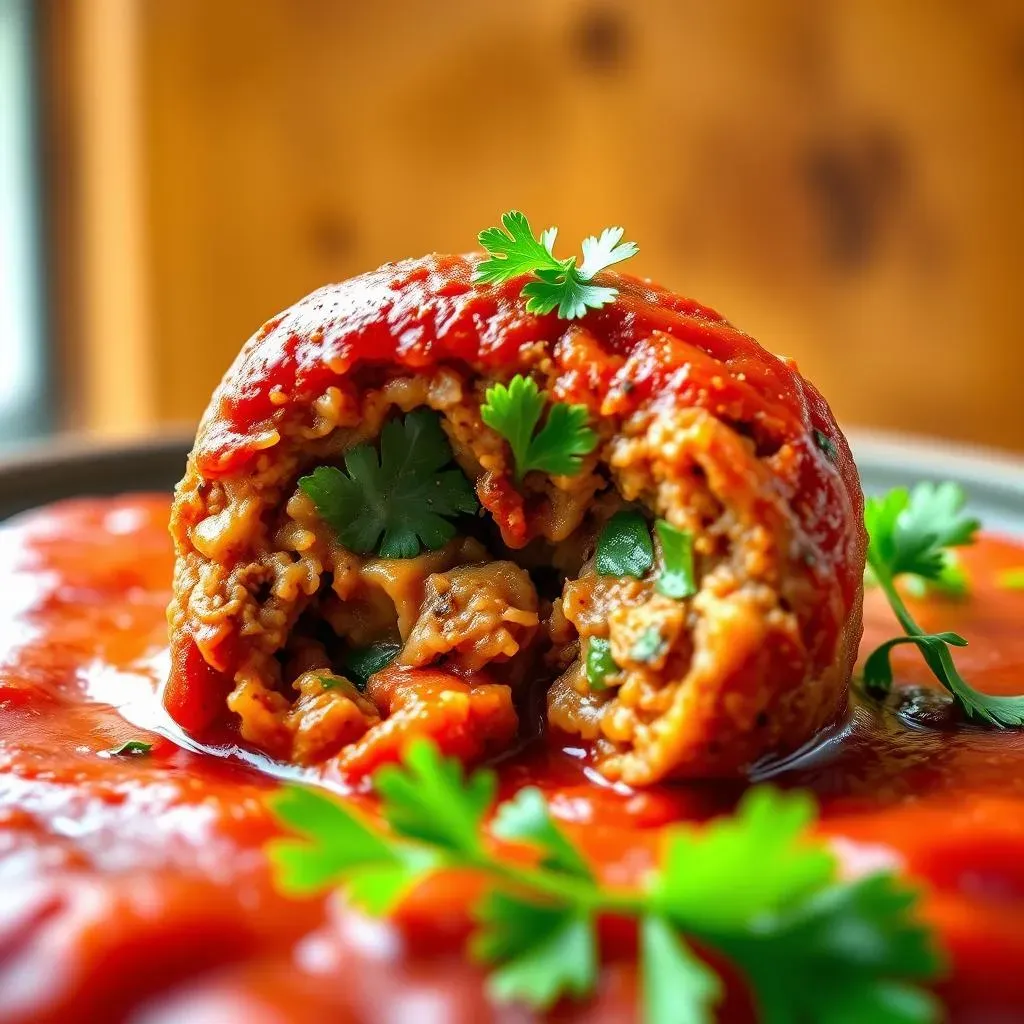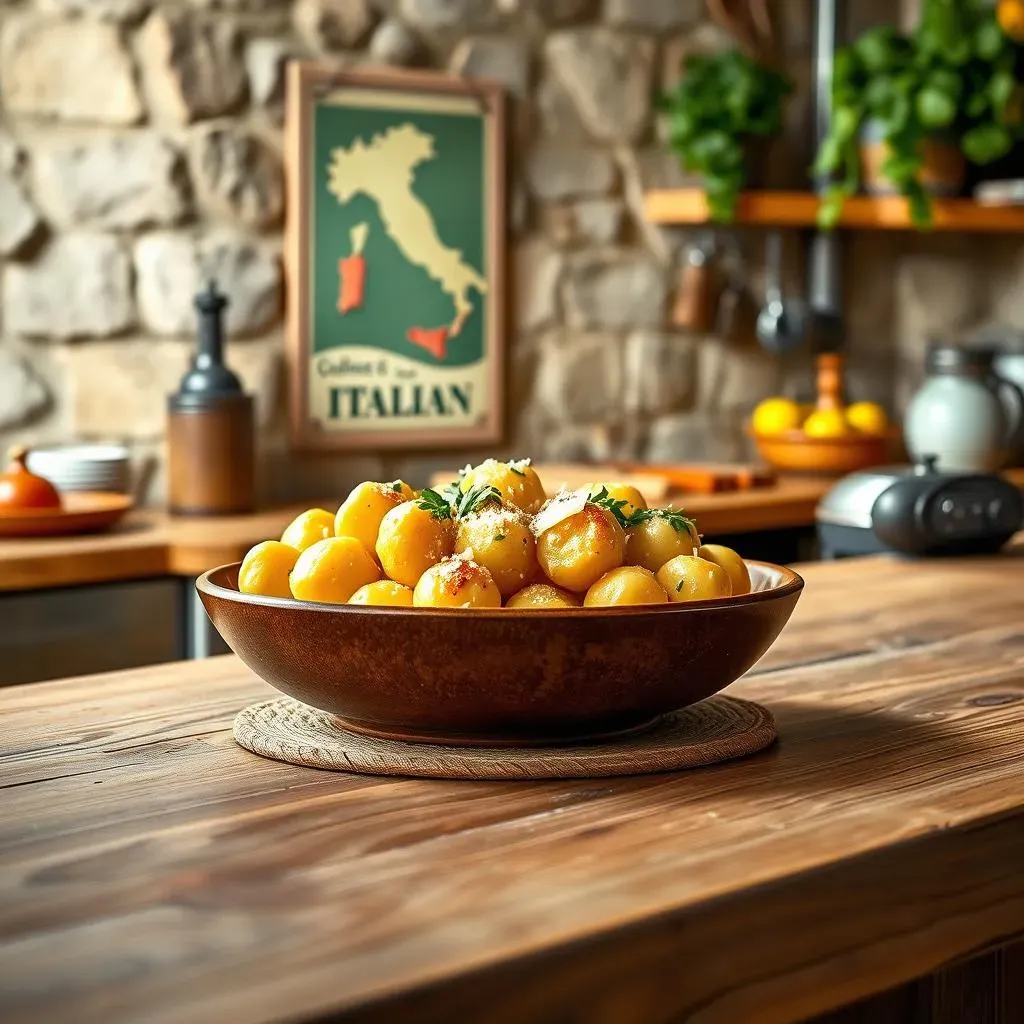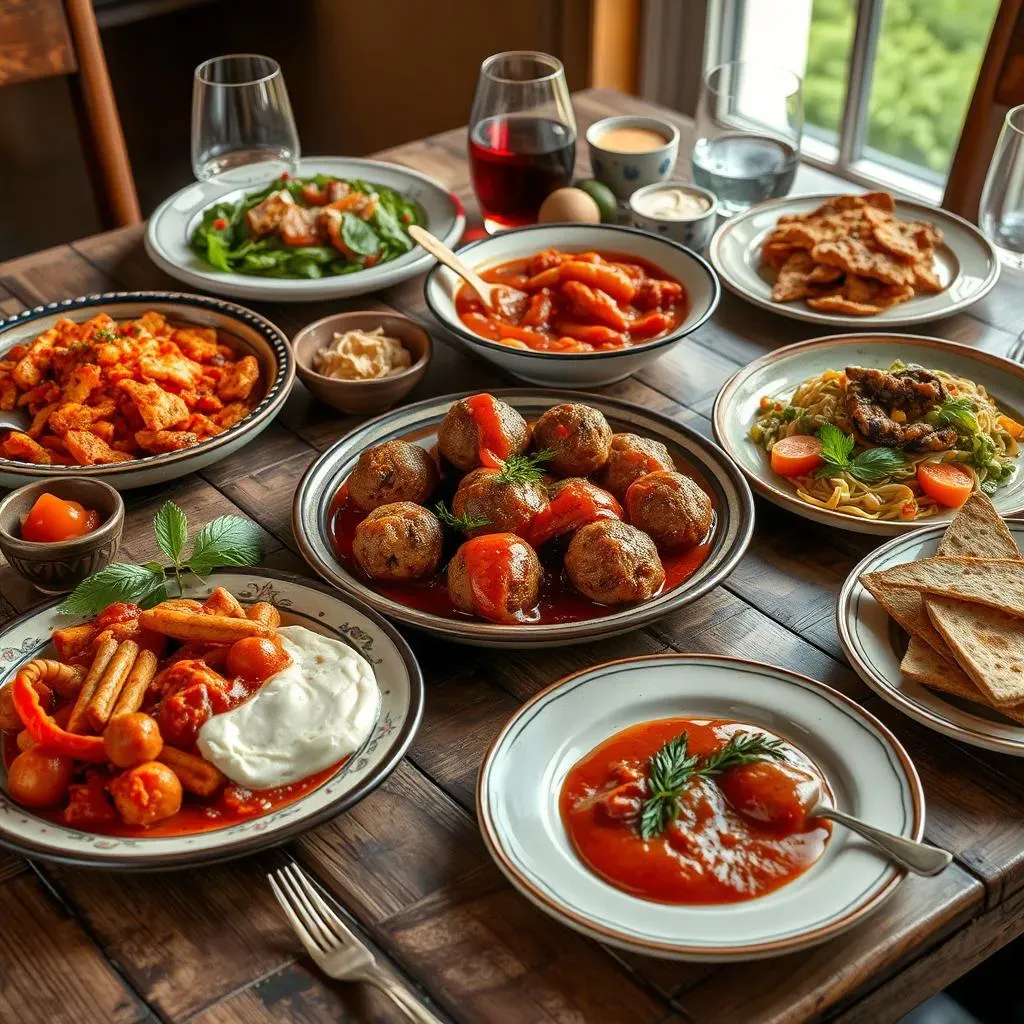Craving a taste of Italy? Forget the oversized, gravy-drenched spheres you might be used to. We're diving headfirst into the world of authentic italian meatball recipes from italy, or as they're lovingly called, "polpette." These aren't your typical Sunday supper meatballs; they're smaller, more refined, and simmered in a simple, yet incredibly flavorful tomato sauce. Think rustic Italian kitchens, the aroma of simmering tomatoes, and Nonna's secret touch.
The Secret to Truly Authentic Italian Meatball Recipes from Italy: Polpette Perfection

The Secret to Truly Authentic Italian Meatball Recipes from Italy: Polpette Perfection
Beyond the Basics: What Makes Polpette "Authentic"?
let's get one thing straight: not all meatballs are created equal. When we talk about authentic italian meatball recipes from italy, we're not just talking about ground meat rolled into a ball. We're talking about a specific culinary tradition, a heritage passed down through generations. It's about respecting the ingredients, the techniques, and the flavors that define true Italian "polpette." Think of it like this: it's the difference between a mass-produced burger and a perfectly crafted, artisanal sandwich. Both might satisfy your hunger, but only one will truly tantalize your taste buds.
So, what are those defining characteristics? First off, it's the size. Forget those softball-sized meatballs you see drowning in marinara. Polpette are typically smaller, bite-sized morsels, perfect for savoring. Then there's the texture. They should be tender, almost melt-in-your-mouth, not dense and chewy. And finally, it's the flavor profile: a delicate balance of meat, cheese, herbs, and spices, all working together in harmony. This is where the magic truly happens. It's a symphony of flavors that tells a story of tradition and family.
The Holy Trinity: Meat, Bread, and Cheese
If polpette were a religion, meat, bread, and cheese would be its holy trinity. These three ingredients form the foundation of any authentic italian meatball recipe from italy. Let's break them down:
- Meat: Traditionally, a combination of ground pork and beef is used. The pork adds richness and moisture, while the beef provides a hearty flavor. Some recipes even incorporate veal for an extra layer of tenderness.
- Bread: This isn't just any bread. Stale bread, soaked in milk, is the secret to achieving that signature tender texture. The bread acts as a binder, absorbing moisture and preventing the meatballs from becoming dry and tough.
- Cheese: Parmigiano-Reggiano is the king of Italian cheeses, and it's a must-have in authentic polpette. Its salty, nutty flavor adds depth and complexity to the meat mixture. Pecorino Romano is another great option, especially if you prefer a sharper, more pungent taste.
Don't skimp on quality here. Using the best ingredients will make a world of difference in the final product. Imagine using pre-shredded, imitation Parmesan versus freshly grated Parmigiano-Reggiano. The difference is night and day!
I remember when I first started making polpette, I tried to cut corners by using pre-ground meat and skipping the bread-soaking step. The result? Dry, flavorless meatballs that were about as far from authentic as you can get. Lesson learned: respect the ingredients, and they will reward you with deliciousness.
The Devil is in the Details: Herbs, Spices, and Technique
so you've got your meat, bread, and cheese. Now it's time to add those extra touches that elevate your authentic italian meatball recipes from italy from good to extraordinary. We're talking herbs, spices, and, most importantly, technique.
Fresh parsley is a must. Its bright, herbaceous flavor adds a touch of freshness that cuts through the richness of the meat. Garlic, finely minced, provides a pungent kick. And a pinch of red pepper flakes adds a subtle warmth. As for spices, keep it simple: salt, pepper, and maybe a touch of nutmeg. Don't overdo it; you want the flavors of the meat, cheese, and herbs to shine through.
But the real secret lies in the technique. Don't overmix the meat mixture! Overmixing will result in tough meatballs. Gently combine the ingredients until just incorporated. And when forming the meatballs, don't pack them too tightly. You want them to be light and airy. A light touch is key here. Think of it like gently cradling a baby bird, not squeezing a stress ball.
Quick Tip:
Before you start mixing, make sure your bread is properly soaked and squeezed dry. You want it to be moist but not soggy. This will ensure that your meatballs are perfectly tender.
Crafting Your Own Polpette: Ingredients and StepbyStep Instructions for Authentic Italian Meatballs

Crafting Your Own Polpette: Ingredients and StepbyStep Instructions for Authentic Italian Meatballs
Gathering Your Arsenal: The Ingredient Checklist
Alright, future polpette pros, let's get down to brass tacks. Before you even think about rolling a meatball, you need to assemble your ingredients. This isn't a time to be shy – quality counts! Here's what you'll need to create authentic italian meatball recipes from italy that would make Nonna proud:
- 1 pound ground pork
- 1 pound ground beef (or veal for extra tenderness)
- 1 cup stale bread, crusts removed
- 1 cup milk
- 2 large eggs, lightly beaten
- 1/2 cup grated Parmigiano-Reggiano cheese
- 1/4 cup chopped fresh parsley
- 2 cloves garlic, finely minced
- 1/2 teaspoon salt
- 1/4 teaspoon black pepper
- Pinch of red pepper flakes (optional)
- Olive oil, for frying
Make sure your bread is truly stale. If it's too fresh, it will turn to mush when soaked in milk. And don't be tempted to use pre-grated cheese. Freshly grated Parmigiano-Reggiano has a much richer, more complex flavor.
From Bowl to Ball: The Step-by-Step Polpette Process
you've got your ingredients. Now it's time to get your hands dirty! Here's a step-by-step guide to crafting your own perfect polpette:
- Soak the bread in milk for about 10 minutes, until softened. Squeeze out the excess milk and discard.
- In a large bowl, combine the ground pork, ground beef, soaked bread, eggs, Parmigiano-Reggiano cheese, parsley, garlic, salt, pepper, and red pepper flakes (if using).
- Gently mix the ingredients together until just combined. Be careful not to overmix!
- Roll the mixture into small meatballs, about 1-inch in diameter.
- Heat a generous amount of olive oil in a large skillet over medium heat.
- Lightly fry the meatballs in batches until browned on all sides. This step is crucial for developing flavor and rendering some of the fat.
- Remove the meatballs from the skillet and set aside.
Remember, the key is a gentle touch. Don't pack the meatballs too tightly, and don't overmix the meat mixture. You want them to be light and tender.
The Frying vs. Baking Debate: Which Method Reigns Supreme?
Ah, the age-old question: to fry or to bake? When it comes to authentic italian meatball recipes from italy, frying is the traditional method. Frying the meatballs in olive oil creates a beautiful crust and adds a depth of flavor that baking simply can't replicate. Plus, it helps render some of the fat, resulting in a more tender meatball.
However, baking is a perfectly acceptable alternative, especially if you're looking to reduce the amount of fat in your dish. If you choose to bake, preheat your oven to 375°F (190°C) and bake the meatballs for about 20-25 minutes, or until cooked through. Just be sure to brush them with olive oil before baking to prevent them from drying out.
Ultimately, the choice is yours. But if you want to experience the true, authentic flavor of polpette, I highly recommend giving frying a try. The extra effort is well worth it!
Frying vs Baking: A Quick Comparison
Method | Pros | Cons |
|---|---|---|
Frying | Superior flavor, crispy crust, renders fat | Higher in fat, requires more attention |
Baking | Lower in fat, easier to manage | Less flavorful, can be dry |
From Simmer to Serve: Mastering the Tomato Sauce for Your Authentic Italian Meatball Recipes

From Simmer to Serve: Mastering the Tomato Sauce for Your Authentic Italian Meatball Recipes
The Soul of the Sauce: Simple Ingredients, Maximum Flavor
You can't have authentic italian meatball recipes from italy without an equally authentic tomato sauce, right? Forget those jarred sauces loaded with sugar and preservatives. We're talking about a simple, rustic sauce that lets the natural sweetness of the tomatoes shine through. The beauty of this sauce is in its simplicity: ripe tomatoes, fragrant garlic, and a touch of olive oil. It's all about letting those high-quality ingredients do the work.
Seriously, I've seen people overcomplicate tomato sauce to the point where it barely resembles what it's supposed to be. Keep it simple! Think of it as a blank canvas for your polpette. It should complement the meatballs, not overpower them. And trust me, a simple sauce, made with love, will always taste better than a complicated one made with shortcuts.
Building Blocks of Brilliance: The Sauce Ingredient Rundown
So, what exactly goes into this magical tomato sauce? Here's the ingredient lineup for your authentic italian meatball recipes from italy:
- 2 tablespoons olive oil
- 2 cloves garlic, finely minced
- 28 ounces crushed tomatoes (preferably San Marzano)
- 1/2 teaspoon dried oregano
- 1/4 teaspoon red pepper flakes (optional)
- Salt and pepper to taste
- Fresh basil leaves, for garnish
San Marzano tomatoes are the gold standard for Italian tomato sauce. Their sweetness and low acidity make them perfect for simmering. But if you can't find them, any good quality crushed tomatoes will do. And don't forget the fresh basil! It adds a touch of freshness that elevates the sauce to another level.
Simmering to Perfection: The Step-by-Step Sauce Symphony
Alright, maestro, let's conduct this sauce symphony! Here's how to create a tomato sauce that will make your authentic italian meatball recipes from italy sing:
- Heat the olive oil in a large saucepan over medium heat.
- Add the garlic and cook for about 1 minute, until fragrant. Be careful not to burn the garlic!
- Add the crushed tomatoes, oregano, red pepper flakes (if using), salt, and pepper.
- Bring the sauce to a simmer, then reduce the heat to low, cover, and cook for at least 30 minutes, or up to 1 hour. The longer it simmers, the more the flavors will meld together.
- Stir occasionally, and add water if the sauce becomes too thick.
- Just before serving, stir in the fresh basil leaves.
Patience is key here. The longer you let the sauce simmer, the richer and more flavorful it will become. And don't be afraid to adjust the seasonings to your liking. Taste as you go, and add more salt, pepper, or red pepper flakes as needed. This is your sauce, so make it your own!
Sauce Customization Options
Ingredient | Purpose | Notes |
|---|---|---|
Onion | Adds sweetness and depth | Sauté with garlic for extra flavor |
Carrot | Adds sweetness and balances acidity | Add diced carrot during simmering |
Red Wine | Adds richness and complexity | Deglaze the pan with red wine after sautéing garlic |
Serving Suggestions and Recipe Variations: Exploring Authentic Italian Meatball Traditions

Serving Suggestions and Recipe Variations: Exploring Authentic Italian Meatball Traditions
From Secondi to Sandwiches: Serving Polpette the Italian Way
Alright, you've got your authentic italian meatball recipes from italy perfected, and the aroma is driving everyone wild. But how do you actually serve these little gems? In Italy, polpette are traditionally served as a "secondo," or second course, after the pasta. They're often presented simply, swimming in that luscious tomato sauce, maybe with a sprinkle of fresh basil. Think of it as a celebration of simple, fresh ingredients, not a mountain of food designed to induce a food coma.
Of course, there's nothing wrong with serving polpette with pasta, especially if you're aiming for that classic Italian-American vibe. But if you want to experience them the authentic way, try serving them on their own, with a side of crusty bread for soaking up all that delicious sauce. Or, get creative and use them to make a killer meatball sandwich. The possibilities are endless!
I remember the first time I had polpette in Italy, I was surprised that they weren't served with spaghetti. But after tasting them on their own, I understood why. The focus was on the meatballs themselves, on their delicate flavor and tender texture. It was a revelation!
Regional Twists: Exploring Polpette Variations Across Italy
Italy is a land of regional specialties, and polpette are no exception. From north to south, you'll find countless variations on this classic dish. In some regions, they add ricotta cheese to the meat mixture for extra creaminess. In others, they incorporate pine nuts and raisins for a touch of sweetness. And in still others, they use different types of meat altogether, such as lamb or chicken. Exploring these regional variations is a delicious way to discover the diversity of Italian cuisine and to put your own spin on authentic italian meatball recipes from italy.
For example, in Sicily, you might find polpette made with swordfish and breadcrumbs, flavored with lemon zest and herbs. In Tuscany, they often add sausage to the meat mixture for a heartier flavor. And in Naples, they're known for their "polpette al ragu," which are simmered in a rich, slow-cooked meat sauce. The possibilities are endless! Don't be afraid to experiment and create your own signature polpette recipe. That’s what cooking is all about, right?
Here's a quick look at some regional variations:
Region | Key Ingredients/Techniques |
|---|---|
Sicily | Swordfish, breadcrumbs, lemon zest, herbs |
Tuscany | Sausage, hearty meat flavor |
Naples | "Polpette al ragu," slow-cooked meat sauce |
Beyond the Basics: Creative Polpette Recipe Ideas
Ready to take your polpette game to the next level? Here are a few creative recipe ideas to inspire you:
- Polpette with Lemon-Butter Sauce: Instead of tomato sauce, serve your polpette with a bright and tangy lemon-butter sauce.
- Polpette Stuffed with Mozzarella: Stuff each meatball with a small cube of mozzarella cheese for a gooey, cheesy surprise.
- Polpette Skewers: Thread your polpette onto skewers with vegetables like zucchini, bell peppers, and onions, and grill them for a fun and flavorful appetizer.
- Vegetarian Polpette: For a vegetarian option, try making polpette with lentils, mushrooms, and breadcrumbs.
The key is to have fun and experiment. Don't be afraid to try new things and to put your own personal touch on authentic italian meatball recipes from italy. After all, cooking is all about creativity and self-expression. So, go ahead, unleash your inner chef and create some polpette magic!
Savoring the Simplicity: Your Authentic Italian Meatball Journey
From humble ingredients to a dish bursting with flavor, crafting authentic Italian meatballs is a testament to the beauty of simple, traditional cooking. You've now unlocked the secrets to creating polpette that would make any Nonna proud. Whether you stick to the classic recipe or experiment with variations, remember that the heart of this dish lies in the quality of ingredients and the love you put into it. So, gather your family, share a plate of these delightful meatballs, and let the flavors of Italy transport you to a sun-drenched trattoria. Buon appetito!